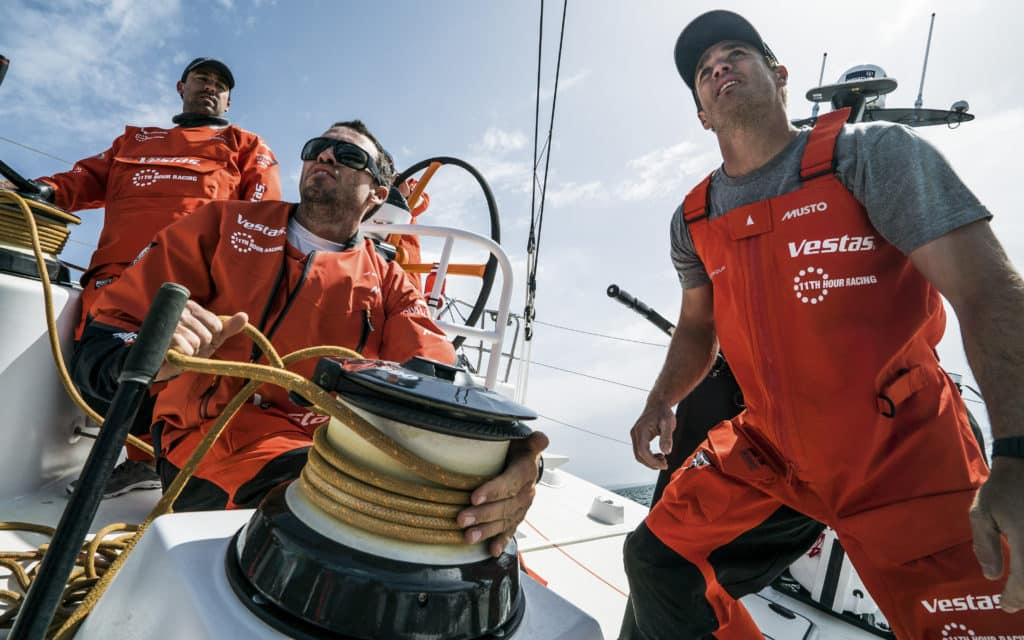
Vestas 11th Hour Racing training
Hailing From: United States/Denmark
Skipper: Charlie Enright
Navigator: Simon Fisher
In the previous edition of the Volvo Ocean Race, Mark Towill and Charlie Enright’s squad on board Alvimedica were billed as the “young guns” of the fleet, a stale characterization that they eventually left in a slithering wake as they rounded Cape Horn first after a brutal and blistering Southern Ocean leg. They weren’t the rookies anymore, nor will they be this time as Vestas 11th Hour Racing.
“It’s no secret we are in this race to win it,” says Towill, “and this time we’ve deemed it that more people is better than less.”
The most notable difference is that Enright and Towill have surrounded themselves with a multinational team stacked with more race experience, says Towill. Among them are true veterans of the race as well as a few free agents from Abu Dhabi Ocean Racing’s winning campaign — notably navigator Simon Fisher and helmsman Phil Harmer. Add to this decorated cast the likes of two-time winner Tony Mutter, returning for his sixth lap. Damian Foxall, the consummate Irish seaman and one-time winner brings an undeniable level of experience to the boat.
“With guys like him and Tony, you can really see it, their approach and their demeanor with everything,” says Towill. “It’s what we need to be surrounded by. Charlie and I still have a lot more to take in, so we’ve surrounded ourselves with people better than us.”
Retaining homie bowman and boat captain Nick Dana (supported by bowman Tom Johnson) and adding two Olympic-caliber females in Hannah Diamond and Jena Mai Hanse, says Towill, gives him a deep and diverse roster to manage from leg to leg, given the expected conditions of each.
“Our focus has been on stacking the boat with great drivers — just like everyone else,” says Towill. “The boats are one-design, the differences are marginal, so it will basically come down to who can make the boat go fast and go in the right direction.”
By the conclusion of the previous race, differences in boatspeed between the top teams were small, and given nothing has dramatically changed with the boats or the sail plans, this version will be “a game of inches,” Towill believes.
To the team’s benefit, Fisher brings with him a trove of performance data from Abu Dhabi Ocean Racing. Over the course of two trans-Atlantic crossings in spring 2017, they continued to mine into the Volvo Ocean 65’s speed potential. “We have their polars and ours, and we’ve been crossing notes on trimming techniques and all that stuff,” says Towill. “They were the faster boat by far when jib reaching, so we’ve picked up a few things there. In the last race, we had a leg up on the fleet in some of the heavy-air running, so all told, I think we are in a better place now.”
One important lesson for Enright and Towill from the previous race was the impact of rotations and the need to plug in experience at key points, especially the Southern Ocean, when they brought on board veteran helmsman Stuart Bannatyne to show them how to push and when to hold back. “Our approach was different then,” says Towill. “It was to have the same team and grow together as a group, but Dongfeng and Abu Dhabi were doing plenty of rotating. There’s a benefit and cost to that, which we couldn’t afford at the time, but we’ll be seeing rotations across the fleet, and we’ll be looking to do them doing it as well.”
They have more people on the roster than they have spots on the boat, however, and they hope to bring one more female to the team, which Towill says will benefit the team in the long run. “Why not have an extra set of hands grinding the sheet on?” he asks, especially when the extra gear that comes along can be stacked and added to the righting moment. Over hundreds of miles, that extra leverage just might make the difference.









